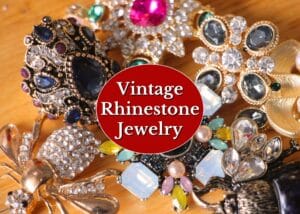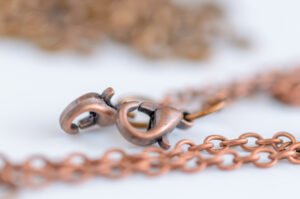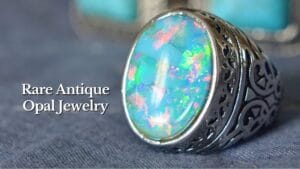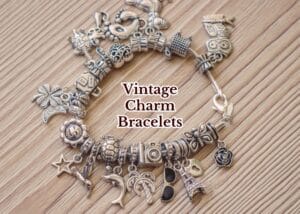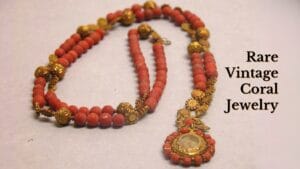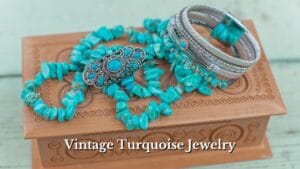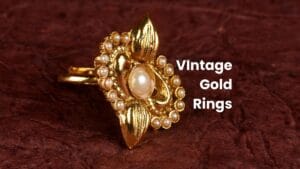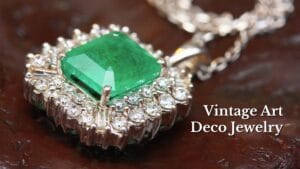Everybody knows old diamond jewelry is extremely precious today. But what if I told you old pieces with those colorful, faux diamonds called “rhinestones” are also highly valuable today? Yes, you can believe me!
Vintage rhinestone pieces from the 1920s-1960s are fetching thousands at auction, but most people overlook them, thinking they’re “just costume jewelry.”
Don’t make that mistake! Learn everything about spotting real vintage rhinestone jewelry, from stone quality to maker’s marks and construction clues. Understand what really makes these pieces valuable, with real examples that will surprise you.
Why Rhinestone Jewelry Became Popular?
Rhinestone is a glass or crystal cut into facets like diamonds to sparkle in jewelry. The name came from those naturally sparkling quartz pebbles that people found in the Rhine River.
Rhinestone jewelry became all the rage in the late 1800s and early 1900s. The middle class wanted to look glamorous but couldn’t afford real diamonds, and Rhinestones solved this. And thanks to Daniel Swarovski, who patented an electric cutting machine in 1892, making perfect rhinestone jewelry got even quicker and cheaper.
From the 1920s flappers to the movie stars of Hollywood’s Golden Age, rhinestone jewelry became a common accessory among all. Today, the earliest pieces are known for their ornate designs & unique stones you won’t find today.
Identifying Real Vintage Rhinestone Jewelry (Key Signs)
To spot real vintage rhinestone jewelry, you need to check everything: the stones, the settings, the hardware, and the way it’s put together! Here’s how to tell authentic pieces from modern replicas.
Stone Features
The first step to identifying rhinestone jewelry is to check the stone. Those in authentic vintage pieces show certain signs that fake stones won’t, such as:
- Material: Real early rhinestones are always glass or crystal. Tap them with something hard; genuine stones make a clear “clink” sound. Plastic fakes sound dull.
- Faceting: The stone’s facets should be sharp and perfectly spaced. They should feel crisp, not rounded or mushy when you touch the surface.
- Clarity: Real stones are crystal clear. No bubbles floating inside or wavy distortions. Just clean the glass all the way through, no matter what color.
- Light Refraction: Hold the piece up to the light and move a little. Quality stones throw off rainbow flashes that dance and sparkle, called “fire.” Modern replicas don’t!
Foil Backing
Flip the piece to see the backing; authentic vintage rhinestone pieces have foil backing that was applied by hand, one stone at a time. You can see the care in how it’s placed. Modern pieces often have sloppy backing.
Also, the foil might show some aging, like slight darkening or gentle wear, and that’s good! But completely black or flaking off backings are a big no, because total deterioration means the piece wasn’t stored properly.
Quality backing in vintage pieces may also maintain its mirror-like shine even after decades.
Base Metals
The metal base varies a lot in vintage Rhinestone pieces. For instance, pot metal was a common alloy used in 1930s-1940s pieces. Many used brass or pewter plated with gold or rhodium to prevent tarnishing. So, most gold-tone jewelry is likely made of brass.
Sterling silver was popular during World War II when other metals were scarce. Also, many pieces from the Pre-1950s period may have nickel in them.
Remember, for gold or silver-plated pieces, the plating would almost always show certain wear, especially on high-contact areas. If it doesn’t, you could be holding a modern replica.
My Tip: To check authenticity, look for natural patina (the gentle darkening or wear) that comes with real age.
Construction Clues
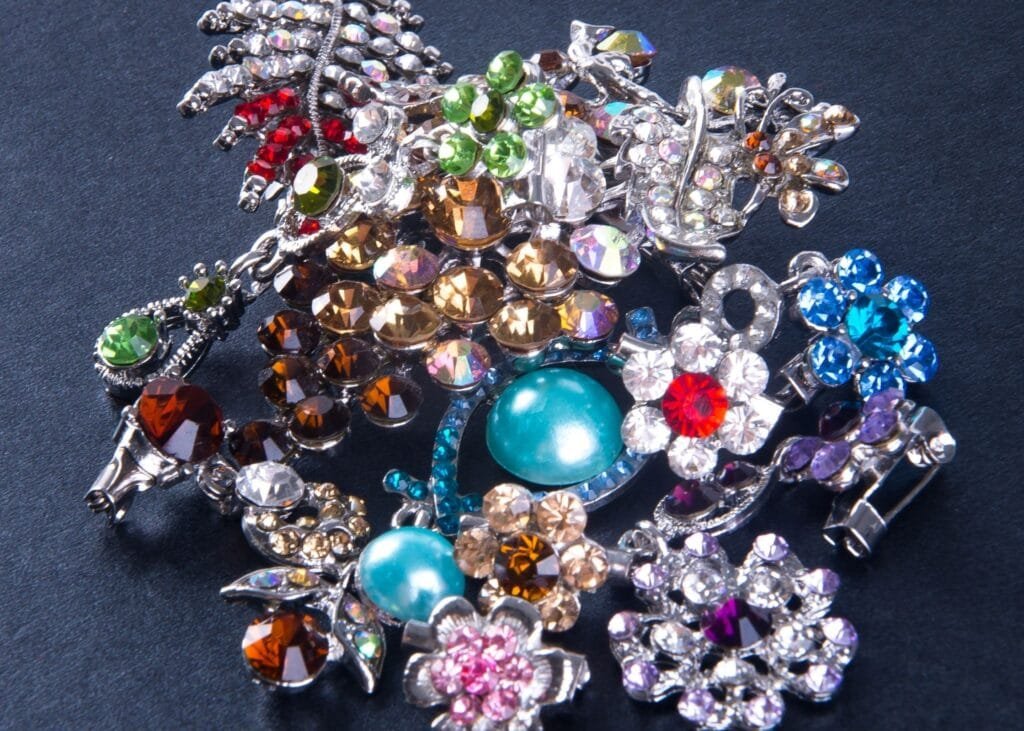
Fine details like how the stone is set into the metal, the closures, and the backs are crucial dating and identification signs. Pay attention to the following:
Stone Setting
Real vintage rhinestone jewelry uses actual metal prongs to hold each stone. These extend past the edge of the stone and wrap around to grip it securely. Also, early pieces feature an open-back setting.
Also, you would clearly see signs of hand-setting, like the prongs might be slightly different on each stone or positioned with tiny variations. Machine-set stones are too perfect and uniform.
And like the stone and setting themselves, the prongs show aging signs; they often get rounded and smooth, which is hard to fake.
On the other hand, most modern rhinestone pieces often just glue stones in place or use tiny metal clips that barely touch the stone. Big difference in both quality and durability.
Closure Hardware
The hardware and mechanical elements, like clasps and backs, used in the jewelry pieces can be great dating clues. For instance, early vintage brooches & pins from the 1900s may have simple C-clasps or T-bar hinges, while roll-over safety clasps were common during the 1920s-1940s.
For necklaces, hook clasps (shepherd’s hooks) were huge in the 1950s and ’60s, especially on chunky multi-strand pieces. Hook and box clasps showed up in the 1920s.
Similarly, screw-backs were standard for earrings and similar pieces from the 1900s through the 1950s. If you see clip-backs, it’s likely from the 1930s to the 1960s, while lever-backs are mostly Victorian or Edwardian.
Also, look for special mechanical features like “tremblers” (rhinestones on tiny springs that move) or hinged sections usually mean higher quality and more collectible pieces.
Maker’s Marks & Signatures
Since designers likely began signing pieces only in the late 1930s, not every vintage rhinestone piece will have a signature or mark. But finding one can be helpful in finding out its origin and age.
So, check the clasps, pin backs, or inner surfaces to find any name or logo stamped or engraved into the material. Be careful with unsigned pieces that sellers try to attribute to famous makers; always double-check.
Note: While marking is important, don’t get fooled! Plenty of dime-store jewelry got signed, too!
Design Details

The way rhinestone jewelry looked changed completely from decade to decade. Once you know the key details and changes, dating pieces get pretty easy.
- Art Deco (1920s-1930s) Pieces: You can spot these by their sharp angles and perfect symmetry. Geometric shapes, like triangles, rectangles, and sunburst patterns, are common. Bold and dramatic colors, often with stylized designs!
- World War Era (1940s) Pieces: Bigger and more sculptural pieces, often with big, chunky bow designs. Ribbons, scrolls, and oversized flowers are common in these pieces.
- Mid-Century (1950s-1970s): Look for figural pieces, from animals and people to flowers and more. Unique three-dimensional designs and aurora borealis rhinestones, plus colored stones, are also common.
How to Know If It’s Valuable?
No doubt vintage Rhinestone jewelry is pretty, but it’s not always valuable. Below, I’ve explained the key factors that determine which pieces are really worth the money!
1. Age & Authenticity
First things first, old rhinestone jewelry will only be valuable if it’s really vintage (made between 20 to 99 years ago) and authentic. So don’t miss assessing the stone, backing, construction, base metal, and design of the piece to make sure the jewelry piece is a real deal.
2. Rarity & Uniqueness
Rare pieces generally tend to be more valuable than those that are commonly found. Here are the things that mean your old rhinestone piece is rare:
- It’s a limited run for specific fashion houses
- It’s a prototype piece that was never mass-produced
- It’s custom orders for celebrities or wealthy clients
- Unusual stone shapes, like teardrops, emerald cuts, navettes.
- Different types of stones in one piece (aurora borealis, frosted glass, striped glass, etc).
3. Condition
Condition is easily the most important thing, because I’ve seen beautiful pieces lose almost 50 to 60% of their value because of missing stones or worn foil.
So, make sure to check your old rhinestone piece for damages like missing or worn-out stones, damaged foil backing, deteriorated plating, missing hardware, and malfunctioning or haywire mechanisms. These can seriously lower the value.
4. Rhinestone Quality & Variety
The cut and clarity of the rhinestone are crucial! The stone should be crystal clear, without any bubbles or other distortions.
Next, unusual shapes like baguettes, teardrops, or navettes are more desirable than basic round stones. Special finishes, like Aurora Borealis coating (a rainbow shimmer Swarovski developed in the 1950s), also tend to be more popular among collectors.

5. Complete Sets
Naturally, complete matching sets, like a demi-parure (a necklace and earring set), are worth way more than the pieces separately. Full sets with three or more pieces? Even more valuable.
Also, original boxes or cards, especially for pieces from popular jewelry houses, can further add to value.
6. Brand Reputation
The value of vintage rhinestone jewelry also largely depends on which fashion house or designer it comes from. Below are some highly collectible brands:
- Swarowski not only mass-produced rhinestones and supplied 85% of American jewelry companies, they’ve also been making amazing pieces.
- Trifari, especially pieces designed by Alfred Philippe between 1930-1968. Look for the crown mark for authentic pieces. They have made pieces for big Hollywood celebs and other significant figures.
- Juliana (D&E) created bold color combinations and innovative stone arrangements that other manufacturers wouldn’t attempt. Fearless design choices that still look modern today.
- Miriam Haskell pieces are hand-wired gems. The construction is immediately obvious; stones and beads individually wired rather than mass-produced. Often features faux pearls and intricate beadwork.
- Schreiner used inverted stones and a hook-and-eye construction style. Most pieces aren’t signed, you couldn’t mistake the iconic style.
- Chanel rhinestone pieces are classics! Karl Lagerfeld’s designs from the 1980s onward are particularly sought after. Look for the interlocking CC logo and exceptional crystal quality. Even unsigned pieces are desirable.
9 Examples of Valuable Vintage Rhinestone Jewelry
Let’s take a look at these vintage rhinestone examples to see how the factors really impact the value!
1. Alfred Philippe Crown Trifari Camellia Jelly Belly Brooch
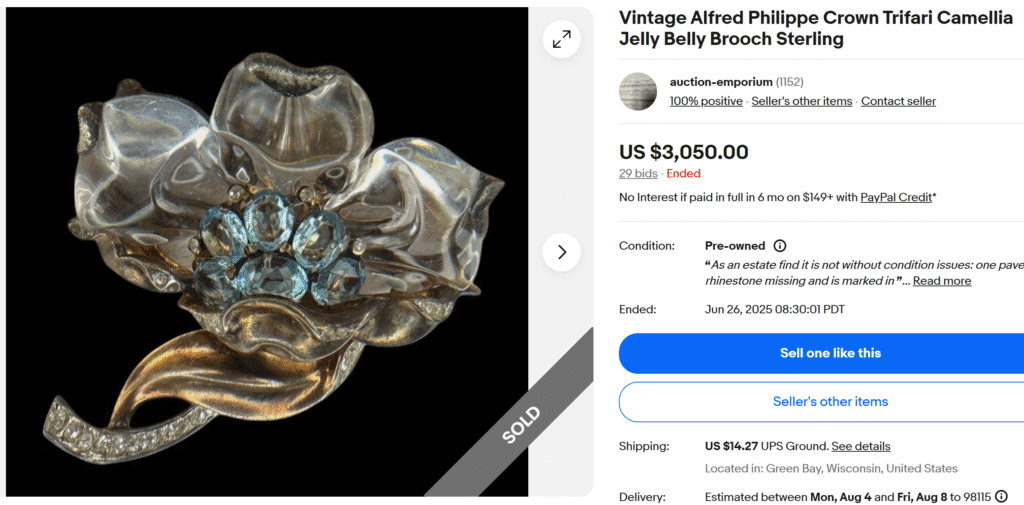
A rhinestone jewelry sold for over $3,000? That’s how the rarity works.
This camellia brooch shows Philippe’s iconic “jelly belly” design with a clear lucite center and surrounding crystal work. Trifari’s jelly belly pieces from the 1940s are among their most collectible designs.
This piece has a sterling silver base with intricate hand-finishing. Prices for Trifari jelly belly pieces range from $185 to $2,500 or more.
Fun Fact: Alfred Philippe was likely one of Trifari’s most famous designers, who had also created fine jewelry for Cartier and Van Cleef & Arpels earlier.
2. Schreiner Blue Rhinestone Cabochon Necklace
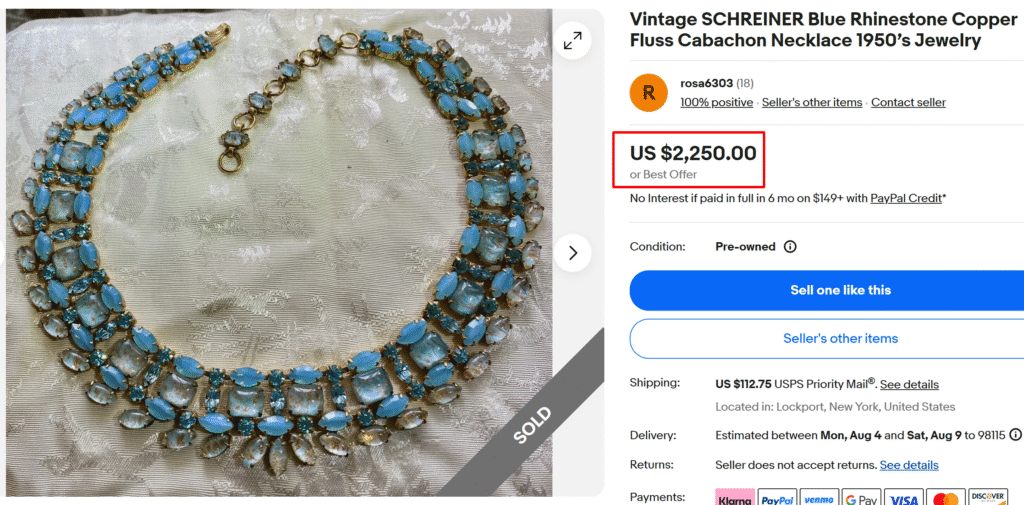
This stunning copper-colored necklace with blue rhinestones from Schreiner sold for a stunning price of $2,250! It shows off Schreiner’s unique technique of flipping rhinestones upside down in their settings!
Schreiner pieces from the 50s and 60s are quite collectible today, as evidenced by the stunning value of this piece. You may need a keen eye to spot the reversed rhinestone pieces.
3. Chanel Ring with Swarovski Rhinestones
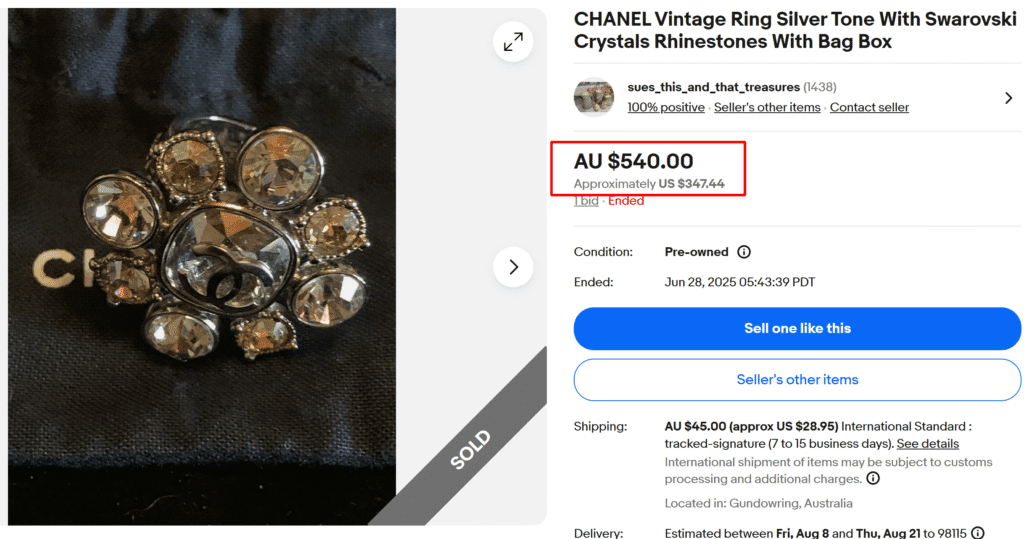
This ring has tons of crystals arranged around the famous double-C logo in silver metal. Real Chanel pieces always use top-notch materials and have crisp, clean markings. You can see champagne and clear crystals cut in different shapes.
The ring also features raised “Paris” and “Chanel” markings with the “CC” logo on the ring, as well. Chanel started signing her jewelry after 1954, but the way to tell when it was made depends on the signature style.
4. Miriam Haskell Signed Brooch Gilt Rhinestone Pin
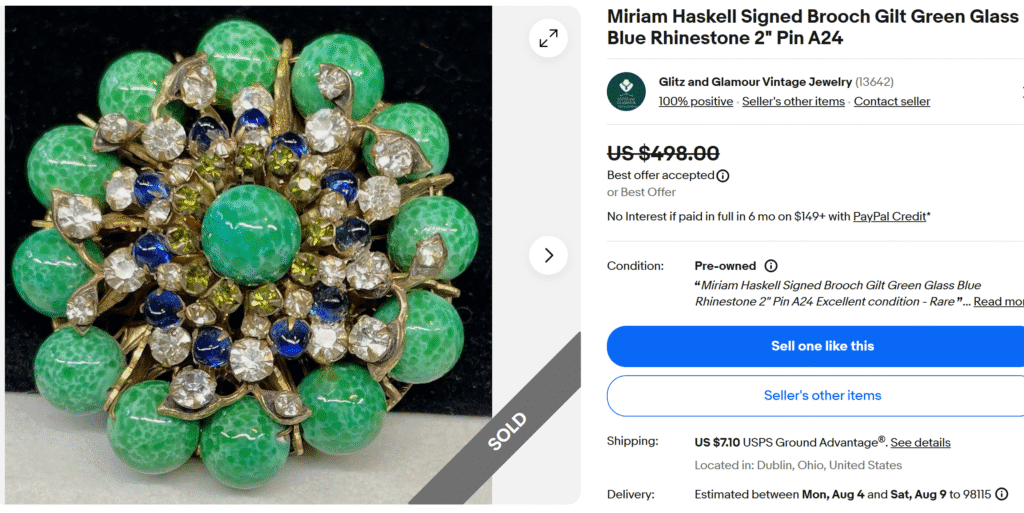
The brooch from Mirian Haskell shows a combination of colorful green, blue, yellow, and clear rhinestone beads in a floral pattern. This piece shows Haskell’s signature signs, like intricate designs with gilt findings, filigree work, and Austrian crystal beads, and it sold for almost $500!
5. Eisenberg Rhinestone Snowflake Brooch
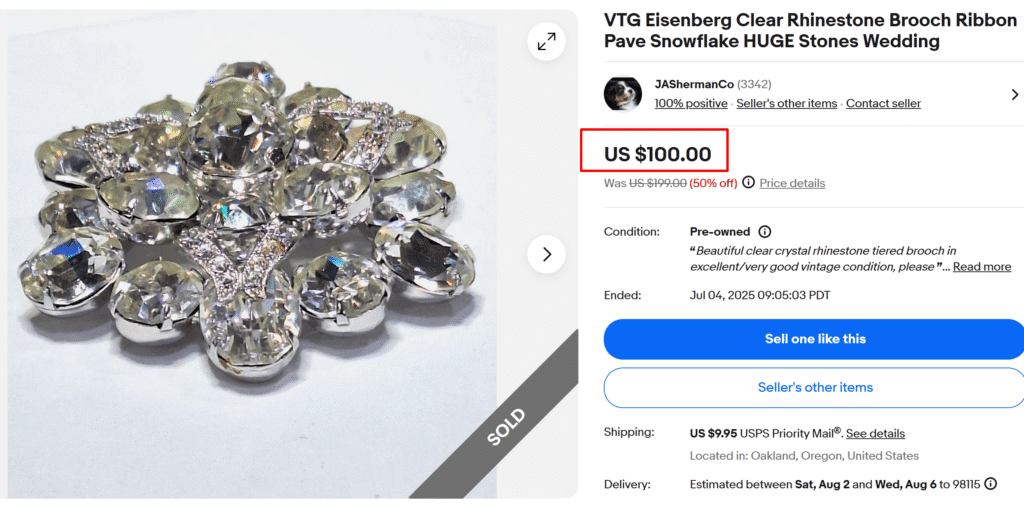
This dazzling snowflake-style brooch features prong-set rhinestones in silver-tone costume metal, one of the defining design elements of Eisenberg. It’s a tiered, dimensional design with large central stones surrounded by smaller pavé work.
Eisenberg is also popular for its high-quality construction using Swarovski crystals. This piece shows the “Eisenberg” block letter marking on the back; pieces from 1935-1945 may have “Eisenberg Original.” 1942 or later pieces may also show the “EISENBERG ICE.”
6. Weiss Black Diamond Rhinestone Brooches

This brooch shows off Weiss’s famous “black diamond” rhinestones – they’re actually smoky-colored crystals that look mysterious and elegant. The stones are set with prongs in a flower spray pattern.
Weiss only operated from 1942 to 1971, so their pieces are already getting scarce. Their “black diamond” work is one of the best color experiments in costume jewelry, making them quite collectible.
7. Juliana D&E Fruit Salad Earrings
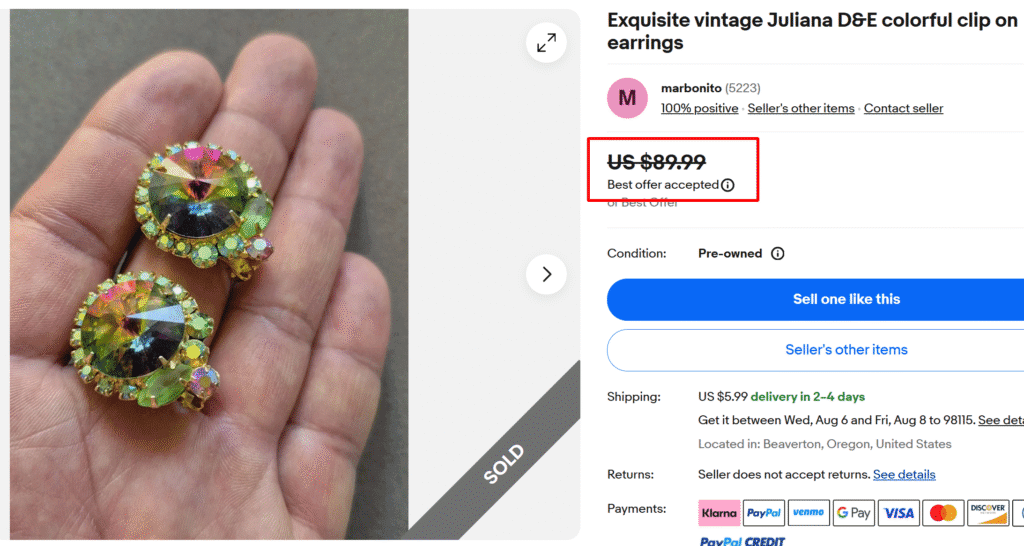
These beautiful and vibrant earrings from DeLizza & Elster feature the classic mix of colored glass stones: emerald green, sapphire blue, and ruby red, all cut in navette shapes and clustered together.
The amazing, colorful design gives them the name “fruit salad.” You’ll also find these pieces with the open-back settings. Since these Juliana pieces were only made for about two years, they’re moderately rare.
8. Sherman Peacock Blue Aurora Borealis Brooch & Earring Set
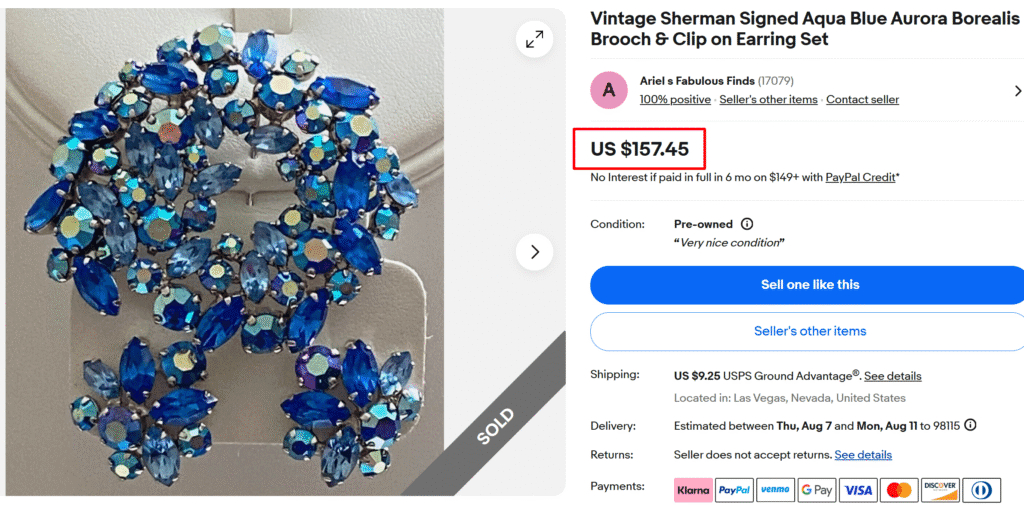
This stunning set features Sherman’s signature Aurora Borealis coating on peacock blue Swarovski crystals. It includes a solid brooch and matching clip earrings, all using Sherman’s trademark thin navette stones and “Sherman” marking.
Sherman rhinestone pieces are valuable, as he worked directly with Christian Dior to develop that Aurora Borealis coating. Also, finding complete matching sets like this is incredibly rare since people often split them up or lose pieces over the years.
9. Kenneth Jay Lane Maltese Cross Brooch
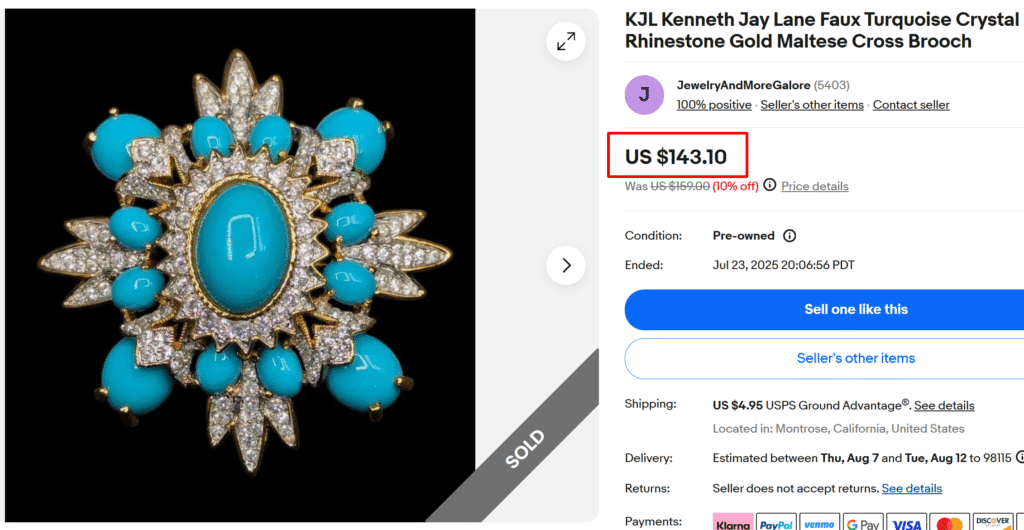
This multipurpose vintage piece works as both a brooch and pendant. It’s designed like a Maltese cross with white cabochon stones and clear rhinestone details. You’ll also find the “KJL” marking with the copyright mark on authentic pieces.
Early K.J.L. pieces, especially ones you can wear multiple ways, are getting harder to find. Lane dressed celebrities and created innovative designs that made costume jewelry respectable. So, real KJL pieces can easily sell for hundreds, based on condition!
Note: This article is intended for informational, educational, and entertainment purposes only. Some images are illustrative and may not represent actual brands, products, or related entities. All trademarks, product names, brand logos, packaging, and other intellectual property referenced remain the exclusive property of their respective owners. Any brand mentions or references are provided solely for descriptive and educational context and do not imply any formal or commercial association.

